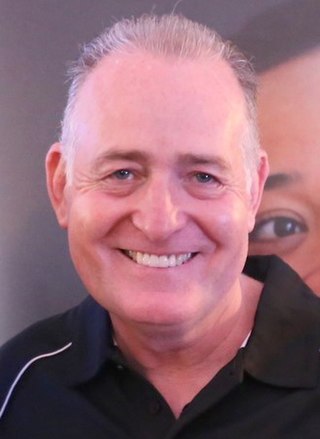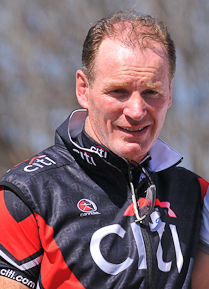Related Research Articles

David Ian Campese, AM, also known as Campo, is a former Australian rugby union player (1982–1996), who was capped by the Wallabies 101 times, and played 85 Tests at wing and 16 at fullback.
Michael Patrick Thomas Lynagh, is an Australian former rugby union player who played 66 Tests at fly-half and six Tests at inside centre between 1984-1995. Lynagh was capped 72 times for Australia, and was captain from 1993 to 1995.
Mark Gordon Ella, AM is an indigenous Australian former rugby union footballer. Ella played at flyhalf/five-eighth and was capped by the Wallabies 25 times, captaining Australia on 10 occasions.

Simon Paul Poidevin is a former Australian rugby union player who played as a flanker. Poidevin made his Test debut for Australia against Fiji during the 1980 tour of Fiji. He was a member of the Wallabies side that defeated New Zealand 2–1 in the 1980 Bledisloe Cup series. He toured with the Eighth Wallabies for the 1984 Australia rugby union tour of Britain and Ireland that won rugby union's "grand slam", the first Australian side to defeat all four home nations, England, Ireland, Wales and Scotland, on a tour. He debuted as captain of the Wallabies in a two-Test series against Argentina in 1986, substituting for the absent Andrew Slack. He was a member of the Wallabies on the 1986 Australia rugby union tour of New Zealand that beat the All Blacks, one of six international teams and second Australian team to win a Test series in New Zealand. During the 1987 Rugby World Cup, he overtook Peter Johnson as Australia's most capped Test player against Japan, captaining the Wallabies for the third time in his 43rd cap. He captained the Wallabies on a fourth and final occasion on the 1987 Australia rugby union tour of Argentina before injury ended his tour prematurely. In 1988, he briefly retired from international rugby, reversing his decision 42 days later ahead of the 1988 Bledisloe Cup series. Following this series, Poidevin returned to the Australian side for the single 1989 Bledisloe Cup Test. He returned full-time to the Australian national squad for the 1991 season. Poidevin was a member of the Wallabies that won the 1991 Rugby World Cup, after which he retired from international rugby union.

Randwick District Rugby Union Football Club, also known as the Galloping Greens, is an Australian rugby union club in the Eastern Suburbs of Sydney which competes in the Sydney premier grade rugby union competition. The club was formed in 1882 and since then has won 32 first grade premierships and six Australian club championships. It is one of the traditional powerhouses of the Shute Shield competition, winning 14 titles from 1978 to 1996. Randwick's colours are myrtle green and the club's home ground is Coogee Oval. In the 1980s the club produced many Wallabies, including the Ella brothers. Its history has seen many of Australia's best players represent the club, including the likes of George Gregan, Rocky Elsom and David Campese. In all, 93 Randwick players have pulled on a Wallaby jersey, and nine have had the honour of captaining their country.
Kenneth William Catchpole was an Australian rugby union footballer. A state and national representative half-back, he played twenty-seven matches for Australia, thirteen as captain. Catchpole rose through the ranks at the Randwick club as a young man, before making his debut for New South Wales at only 19 years of age, then captaining Australia at age 21. He is considered one of Australia's greatest rugby scrumhalves.
Michael David O'Connor is an Australian former rugby league and rugby union footballer who represented Australia in both codes. He played for the Wallabies in 13 Tests from 1979 to 1982 and then the Kangaroos in 17 Tests from 1985 to 1990. O'Connor played club football in the NSWRL Premiership for the St. George Dragons from 1983 until 1986, and later the Manly-Warringah Sea Eagles from 1987 until his retirement at the end of 1992, becoming captain of Manly in 1990, as well as winning the 1987 Winfield Cup with the Sea Eagles.
The 1984 Australia rugby union tour of Britain and Ireland was a series of eighteen matches played by the Australia national rugby union team in Britain and Ireland between 17 October and 15 December 1984. The Australian team won thirteen matches, drew one and lost four but notably won all four of their international matches.
Colin "Col" Windon, was a rugby union player and soldier who captained Australia – the Wallabies – in two Test matches in 1951. By age 18 Windon was playing at flanker for his club Randwick in Sydney's Shute Shield. After serving with the Second Australian Imperial Force in the Pacific Theatre during the Second World War, Windon resumed his rugby career in 1946. He was first selected for Australia for their tour of New Zealand that year. Despite the Wallabies losing both their Tests on tour, Windon impressed with his play.
The 1982 Kangaroo tour was the fifteenth Kangaroo tour where the Australian national rugby league team played a number of matches against British and French rugby league teams, in addition to the Test matches. The Australia national rugby league team have generally since 1908 barring wartime, toured Great Britain every four years often capping the tour with matches and Tests in France. This regular touring side are known as the Kangaroos.
The 1991 Rugby World Cup Final was the final match of the 1991 Rugby World Cup, the second edition of the rugby union competition, to decide the world champions. The match was played on 2 November 1991 at Twickenham Stadium, London, and was contested by the host nation England, and Australia. Australia won the match 12–6.
The 1981–82 Australia rugby union tour of Britain and Ireland was a series of matches played by the Australia national rugby union team. The touring team played twenty-three matches between October 1981 and January 1982, winning sixteen games, drawing one and losing six. The scheduled final game, against the Barbarians, was cancelled due to heavy snow.
The 1982 Australia rugby union tour of New Zealand was a series of fourteen matches played by the Australia national rugby union team in New Zealand between July and September 1982. The Wallabies won ten of the fourteen matches and lost the other four. The international match series against the New Zealand national rugby union team resulted in a 2–1 win for New Zealand, who won the first and third matches, with Australia winning the second match. New Zealand thereby regained the Bledisloe Cup, which had been held by Australia since 1979.
The 1980 Australia rugby union tour of Fiji was a series of 3 matches played in May 1980 by Australia in Fiji.
The 1983 Australia rugby union tour of Italy and France was a series of matches played between October and November 1983 in Italy and France by Australia.
The 1986 Australia rugby union tour of New Zealand was a series of matches played by Australia national rugby union team in New Zealand between July and September 1986. Australia won the series against New Zealand with two victories in three matches.
The 1991 Australia rugby union tour of New Zealand consisted of two matches played by the Wallabies in August 1991.
The 1984 Australia rugby union tour of Fiji was a series of 3 matches played in May 1984 by Australia in Fiji.
Roger Gould is a former rugby union player who played fullback for both the Australian Wallabies and the Queensland Reds. He first played for Queensland in 1978 and for Australia in 1980. His last match for Australia was in the 1987 World Cup. Although Gould's career was cut short due to injury, he is widely considered one of the greatest fullbacks to ever play for Australia.
References
- ↑ Bath, Richard (ed.) The Complete Book of Rugby (Seven Oaks Ltd, 1997 ISBN 1-86200-013-1) p72
- 1 2 3 4 5 Ella & Smith 1987, p. 54.
- ↑ Campese & Bills 1991, p. 37.
- 1 2 3 Campese & Bills 1991, p. 174.
- 1 2 3 4 5 Campese 2003, p. 208.
- 1 2 3 Ella 1995, p. 123.
- 1 2 Ella & Smith 1987, p. 37.
- ↑ Slack 1995, p. 177.
- 1 2 Ella & Smith 1987, p. 154.
- ↑ Campese 1996, p. 101.
- ↑ Derriman 2003, p. 92.
- ↑ Derriman 2003, p. 93.
- ↑ Cooper 1985, p. 27.
- ↑ Ella & Smith 1987, p. 55.
- ↑ Poidevin & Webster 1991, p. 92.
- ↑ Poidevin & Webster 1991, p. 233.
- ↑ Poidevin & Webster 1991, p. 229.
- ↑ Campese 1996, pp. 99–101.
- ↑ Ella 1995, p. 37.
- ↑ "Mr Brendan Joseph Moon". It's an Honour. Retrieved 12 June 2022.
- ↑ "Mr Brendan Joseph Moon". It's an Honour. Retrieved 12 June 2022.
Printed
- Campese, David; Bills, Peter (1991). On a Wing and a Prayer. Queen Anne Press. ISBN 0-356-17958-3.
- Campese, David; Meninga, Mal; Jenkins, Peter; Frilingos, Peter (1994). My Game Your Game: David Campese and Mal Meninga Talk Football. Pan Macmillan Australia. ISBN 9780330356169.
- Campese, David (2003). Campo: Still Entertaining. Flick Pass Productions. ISBN 978-0975113004.
- Campese, David (1996). David Campese: Ironbark Legends. Pan Macmillan Australia. ISBN 0-7329-0850-7.
- Cooper, Terry (1985). Victorious Wallabies: U.K. Tour 1984. Waterloo Press. ISBN 0-7257-0314-8.
- Derriman, Philip (2003). The Rise & Rise of Australian Rugby. ABC Books. ISBN 0-7333-1329-9.
- Ella, Mark; Smith, Terry (1987). Path to Victory: Wallaby Power in the 1980s. ABC Enterprises. ISBN 0-642-52766-0.
- Ella, Mark (1995). Running Rugby. ABC Books. ISBN 0-7333-0359-5.
- Poidevin, Simon; Webster, Jim (1991). For Love Not Money. ABC Books. ISBN 0-7333-0148-7.
- Slack, Andrew (1995). Noddy: The Authorised Biography of Michael Lynagh. William Heinemann Australia a part of Reed Books Australia. ISBN 0-85561-571-0.